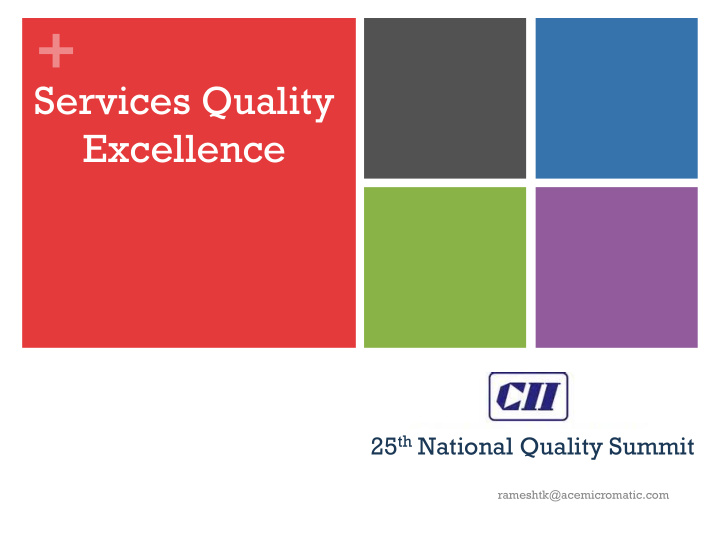



+ Services Quality Excellence 25 th National Quality Summit rameshtk@acemicromatic.com 1
+ The Changing Environment Globalization Liberalization Socio Economic Shifts Awareness & Attitudes
+ Defining Quality “ although we cannot define quality, we know what quality is ” (Pirsig, 1987) Service quality is a measure of how well the service level delivered matches customer expectations. Delivering quality service means conforming to customer expectations on a consistent basis (Lewis and Booms1983) ‘ service quality results from a comparison of what customers feel a service provider should offer (i.e. their expectations) with the provider ’ s actual performance ’ (Parasuraman, 1996) ‘ 3
+ Why is Quality Important? Superior product/service quality relative to competitors is the single most important factor affecting profitability (PIMS study) Premium prices Customer preference Customer retention Market expansion/market share Other benefits: productivity, distribution/access 4
+ Changing management focus 5 Customer Experience 2010+ Creating better value for customers and 2000 ’ s the organisation Quality 1990 ’ s Productivity 1980 ’ s
+ The Four Components Of Service Service Service Delivery Product Physical Product Service Environment Physical product : Automobile Service Product : Loans ; Warranty ; Registration of vehicle : Showroom ; workshop ; parking …. Service Environment Service Delivery : Repair time ; delivery time ; sales response (Source : Adapted from Roland T.Rust and Richard.L.Oliver (1993), Service quality: Insights and managerial implications from the frontier, in Service Quality)
+ Characteristics Of The Service Product Extent to which equipment or facility based attributes form part of Extent to which people based attributes form part of the the service product High • Telephone • Five-star hotel • Passenger • Hospital airline • Retail banking - • Car rental ATM / Internet service product • Retail banking • Freight transportation ( with human tellers ) • Movie theater • College education High Low • Tax preparation • Corporate banking • Management consulting Low (Source : Adapted from Roland T.Rust and Richard.L.Oliver (1993), Service quality: Insights and managerial implications from the frontier, in Service Quality)
+ Dimensions Of Customer Service Customer Service has two dimensions : Procedural Personal Dimension Dimension QUALITY SERVICE PROCEDURAL DIMENSIONS of service consists of the systems and procedures of the company to deliver products / services. This addresses the WHAT of the service delivered. PERSONAL DIMENSIONS of service consists of how the people in the company interact with customers. This aspect covers their attitudes, behaviour, communication and interpersonal relations. This addresses the HOW of the service delivered.
+ THE SERVICE QUALITY GAP What leads to customer satisfaction or dissatisfaction ? Gap between - What the customer expects and what the customer thinks he gets Customer Expectation Service Quality Gap Perceived Delivered Service The size of the Service Quality Gap will decide the extent of customer satisfaction or dissatisfaction
+ Our Role: To Bridge The Service Quality Gap By understanding customer ? expectations By meeting customer expectations HOW ? By managing Customer perceptions
+ How Are Customers Expectations Influenced ? Customer needs Past Word of mouth experience Options available • Customer expectations are met by understanding customer needs. • Customers Perceptions are managed through effective communications
+ ISSUES WE NEED TO UNDERSTAND How do our customers What do we perceive perceive and to be the key attributes evaluate the quality of service quality ? of service? ? How do we bridge the gap Are there discrepancies between the between the service customer’s perceptions perceptions of and ours ? customers and our company ?
+ Gaps Model of Service Quality Word of Mouth Personal Needs Past Experience Communications Expected Service Customer Gap Perceived Service Customer Company External Communications Service Delivery to Customers Gap 1 Gap 4 Gap 3 Customer Driven Service Design Gap 2 Company Perceptions of Consumer Expectations (Parasuraman, Zeithaml & Berry, 1985) 13
+ Service Quality Gaps Company Perception Customer of Customer Expectations Expectations Gap 1 – Not knowing what customers expect Inadequate market research Poor market segmentation Lack of upward communication (contact employees to managers) Insufficient customer relationship focus Inadequate service recovery 14
+ Service Quality Gaps Company Perception Customer-Driven of Customer Service Design & Expectations Standards Gap 2 – incorrect service design & standards Inability to translate customer expectations into clear quality specifications Lack of management commitment to service quality Customer expectations thought to be unreasonable or unfeasible Absence of a formal quality programme (guidelines, standards) Poor service design 15
+ Service Quality Gaps Customer-Driven Service Delivery Service Design & Standards Gap 3 – Not delivering to service standards Employees unwilling or unable to perform the service at the desired level Poor internal organisation ineffective recruitment, inadequate teamwork, employees not motivated, role conflict, role ambiguity, poor supervision Poor employee-technology job fit (appropriate tools to perform roles) Failure to match supply and demand Customers unaware of roles and responsibilities Problems with service intermediaries 16
+ Service Quality Gaps External Service Delivery Communications to Customers Gap 4 – Promises do not match performance Over-promising in advertising, personal selling or physical evidence cues Management wants to show services offered in best possible light Poorly-integrated marketing communications Insufficient communication between marketing/sales & operations Ineffective management of customer expectations 17
+
Recommend
More recommend